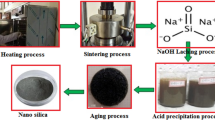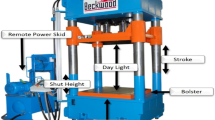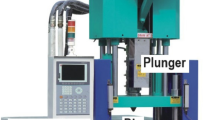Abstract
Hybrid polymer nanocomposite is embraced with natural fiber, promising applications because of better flexural strength, water resistance, lower moisture absorption, and extended life span. Besides, it faces the difficulties of poor adhesive quality and larger moisture absorption nature outcomes, as well as a lack of composite performance. The novel work is to synthesize the hybrid high-density polyethylene (HDPE) nanocomposite by the adaptations of 20 vol% chopped bast fiber, and 2, 4, and 6 vol% of nano-alumina (Al2O3) particles through hand layup aided thermal compression route, and its absorption of moisture, tensile strength, and hardness is measured. The hybrid high-density polyethylene nanocomposite primed with 20 vol% bast fiber and 6 vol% nano-Al2O3 attained a low moisture absorption percentage (7 ± 0.2%), a high tensile strength of 48 ± 2 MPa, and better hardness of 45 ± 0.2 HV, which are greater than the HDPE without bast fiber and nano-Al2O3 particles.
Similar content being viewed by others
Explore related subjects
Discover the latest articles, news and stories from top researchers in related subjects.Avoid common mistakes on your manuscript.
Introduction
Substituting natural fiber instead of synthetic fiber is the future for potential application during polymer composite production [1]. Natural fiber reflects poly-composite fabrication with prominent qualities such as reduced weight, biodegradability, good strength, nontoxicity, and ease of recycling [2, 3]. By implementing chemical processing, the natural fiber quality is enhanced with better adhesive qualities [4, 5]. Likewise, the assortment of the matrix material, reinforcements (size and shape), processing, and its parameters determine the qualities of the composite [6]. With distinct characteristics such as better strength, flexibility, ductility, excellent chemical resistance, and economic reasons, the HDPE polymer was selected for bon replacement applications [7].
Basalt and bast fiber implementations for automobile components applications enriched the polypropylene composite functional characteristics. The appearance of natural fiber tailored enhanced mechanical properties such as 39 and 44% enhancement in tensile and flexural strength of composite [8]. Sergi et al. [9] tested the life span of HDPE poly-composites made by hemp/basalt fiber combinations. The output showed that UV radiation, hydrothermal stress, and tensile performance were highly related to mono-HDPE polymer. They summarized that the higher loading content of natural fiber offered a superior life span and better tensile performance. Aji et al. [10] measured the dynamic mechanical analysis of PALF and kenaf fiber incorporated HDPE composite. The HDPE composite quality was enriched by adding a lower loading rate for pineapple leaf, and varied loading content of kenaf fiber proved enhanced composite impact and tensile strength. They identified irrelevant dynamic loss due to unrated fiber length. Group of natural fibers, the bast fiber included green polymer-based composites of superior quality and durability. Faruque et al. [11] reviewed and summarized the categories of processing, behavior, and applications of HDPE green composites synthesized with bast fiber. Recently, Gao et al. [12] developed an HDPE composite with varied straw fiber compositions and measured its quality. Scanning electron microscope exposed the straw fiber appearance in the HDPE matrix and was liked effectively. They noted good mechanical qualities with an extended life span. Metallographic, physical, flexural, and tensile qualities were measured with inclusions of oil palm pressed fruit and jute fiber in a hybrid high-density polyethylene composite. The chemical-processed natural fiber with 20 wt% loading of jute fiber performed superior flexural, tensile, and physical qualities. The metallographic studies effectively linked HDPE and natural fiber structures [13]. The HDPE green composite was synthesized using a hot press machine, and its physical, surface morphology, and mechanical qualities were measured using the ASTM procedure. The findings showed that superior adhesive behavior results improved the mechanical qualities of composite and applied for lightweight applications [14]. Besides, the high-density polyethylene composites were hybridized by the adaptations of natural fiber, resulting in enhanced impact toughness and excellent behavior [15].
According to the past literature, the processing of HDPE composite with natural fiber found low moisture absorption, tensile, and hardness values, and to overtake the issues, the current research aims to synthesize the hybrid HDPE nanocomposite with constant volume percentages (20%) of bast fiber treated by sodium hydroxide solution and its characteristics enriched via nano-alumina particle as 2, 4, and 6 vol% via hand layup associated with the thermal press. The synthesized HDPE and hybrid HDPE nanocomposite's moisture percentage, tensile, and hardness are measured and spot the hybrid HDPE nanocomposite with 20 vol% bast fiber and 6 vol% nano-alumina has maximum tensile strength and hardness and low moisture absorption qualities related to other samples.
Materials and Methods
High-density polyethylene is a matrix because of its high strength, durability, low moisture absorption, and inert nature [9, 10]. The bast fiber and nano (50 nm)-alumina particles are picked as reinforcement and filler material for HDPE composite fabrication. Faruque et al. [11] summarized bast fiber developed composite and 20 vol% bast fiber own better mechanical and thermal behavior. For this reason, the present study is considered by 20 vol%. Besides, alumina nanoparticles have better stability, hardness, and thermal behavior [16]. The alumina nanoparticle is chosen as filler material. The bast fiber is involved in 5% sodium hydroxide solution treatment to enhance the bonding quality [11]. Likewise, the alumina particles are heated at 200 °C for a span of 10 min. It assists in eliminating the unwanted moisture content. Based on Table 1, the HDPE composites were synthesized. Table 2 indicates the properties of HDPE, bast fiber, and alumina nanoparticles.
Synthesis of HDPE and Hybrid HDPE Nanocomposite
The high-density polyethylene composite is established using a layup route associated with thermal pressing methods exposed in Fig. 1a and b, respectively. The HDPE sheet is placed over the hand layup table, and resin is applied. For now, the 20 vol% bast fiber and 2 vol% nano-alumina particles are blended uniformly through a blender machine. The bast fiber and alumina nanoparticles are uniformly blended with an epoxy resin/hardener combination and applied over the HDPE layer. The next HDPE mat is placed over the layer. Finally, the compacted composite materials are covered with a Teflon sheet and placed in the thermal pressing machine with an applied temperature of 120–140 °C for 20–40 s at 20 MPa. Finally, the composite plates are shaped by behavior measurements.
Characteristics Study of Composite
The moisture absorption behavior of the composite is evaluated for 1 week, and its absorption behavior is measured and followed by ASTM D57 every day. FIE's tensile testing machine is used to measure the tensile behavior of HDPE hybrid nanocomposite with an applied feed rate of 2 mm/min, followed by the ASTM D3039 standard. With the ASTM D4762 standard, the hardness of developed composites is studied with a 100-g load at 10 s. Besides, the three trials are tested from each composite sample, and the three averages are considered a mean value with a permissible error of 5%.
Results and Discussion
Absorption of Moisture Behavior of Composite
The influence of bast fiber and nano-Al2O3 particles on moisture absorption percentages in high-density polyethylene composites is presented in Fig. 2.
Generally, the HDPE material has resistance to chemicals and good strength [6]. Here, Fig. 2 exposed the downtrend on the exposure of nano-Al2O3 particles as 2, 4, and 6 vol%, respectively. The HDPE bonded with 20 vol% bast fiber indicates 10 ± 0.5% moisture absorption and is exploited by 9 ± 0.3% on loading 20 vol% bast fiber with 6 vol% nano-Al2O3 particles. The sodium hydroxide-treated bast fiber offered good moisture absorption resistance behavior compared to HDPE. Moreover, the improved loading content of nano-Al2O3 particles in HDPE/20 vol% bast fiber explored better moisture absorption resistance percentage, and hybrid HDPE nanocomposite HNC3 is limited by 42% in moisture absorption resistance percentage. The NaOH-treated bast fiber, influenced by the better adhesive quality, reduced porosity, and improved crystallinity, reduces the overall moisture absorption percentage of HDPE composite.
Tensile Strength Behavior of Composite
The tensile strength performance of HDPE and HDPE HNC 1, 2, and 3 exposed in Fig. 3 and identified as uptrend because of good adhesive bonding strength within the matrix, and bast fiber/nano-Al2O3 particles could endure the tensile load. Previously, Negawo et al. [14] summarized the content of natural fiber appearance in the HDPE matrix facilitated maximum mechanical strength qualities.
The tensile strength of HDPE composite made with 20 vol% bast fiber is 33 ± 0.2 MPa, and the inclusion of 2 vol% of nano-Al2O3 particles in HDPE matrix shown 36 ± 0.1 MPa for a reason for the effective pinning strength may restrict the fiber and particle displacement. The loading of nano-Al2O3 particles greater than 2 vol% notified the uptrend of the tensile strength of the composite. Besides, the HDPE HNC3 composite has maximum tensile strength quality and relates with HDPE, which is enhanced by 45.45%. The hybrid combinations cause the better tensile performance of the composite. The same approach is reported by Ahmed et al. [15]. The effective adhesive joint strength, increased fiber crystallinity, decreased moisture absorption, and surface impurities are the prime reason for the enhancement of tensile strength. A similar trend is reported by Adin and Kilickap [17].
Hardness Behavior of Composite
The nature of HDPE is low hardness value [18, 19] and is enriched by adding the 20 vol% bast fiber and 2, 4, and 6 vol% of nano-Al2O3 particles. Here, Fig. 4 indicates the hardness value of HDPE and its hybrid HDPE nanocomposites. Besides, it exploited significant enhancement in hardness value compared to HDPE composite.
The hardness value of HDPE with 20 vol% bast fiber is 22 ± 0.1HV and raised by the inclusions of 2 vol% of nano-Al2O3 particles liberates 35 ± 0.2HV for coarse bonded structure with reduced particle gap. The HDPE HNC2 composite hardness indicated 41 ± 0.2HV and attained a maximum hardness of 45 ± 0.2HV on 6 vol% of nano-Al2O3 particles in HDPE/20 vol% bast fiber. The fine dispersion of nano-Al2O3 particles interlinked with bast fiber causes good hardness value and is enhanced by 104% compared to 20 vol% bast fiber in HDPE composite. The combination of ceramic and fiber enhanced the maximum hardness value [20, 21].
Conclusions
The hybrid high-density polyethylene nanocomposite is produced by a constant volume percentage of bast fiber (20%) and varied loading of nano-alumina through a hand layup route associated with the thermal mold process. The qualities such as moisture absorption resistance percentage, tensile strength, and hardness of HDPE and HDPE HNC1, HNC2, and HNC3 are measured using the ASTM approach. The appearance of nano-alumina loading in HDPE/20 vol% facilitates excellent performance, and the hybrid HDPE nanocomposite (HDPE HNC3—HDPE/20 vol% bast fiber/6 vol% nano-Al2O3 particles) is indicated optimum performance related to other HDPE composite specimen. The moisture absorption resistance percentage, tensile strength, and hardness of HDPE HNC3 hybrid nanocomposite were enhanced by 42%, 45.45%, and 104%, comparable to HDPE composite made with 20 vol% of bast fiber (sodium hydroxide treated).
Data Availability
All the data required are available within the manuscript.
References
R. Sasikumar et al., Effect of tamarind fruit fiber contribution in epoxy resin composites as biodegradable nature: characterization and property evaluation. Biomass Convers. Biorefin. 16, 1–9 (2023)
E. Nampoothiri et al., Experimental investigation on mechanical and biodegradation properties of Indian almond–kenaf fiber-reinforced hybrid composites for construction applications. J. Nat. Fibers 19(1), 292–302 (2022)
M. Asim et al., Thermal stability of natural fibers and their polymer composites. Iran. Polym. J.Polym. J. 29, 625–648 (2020)
R. Venkatesh et al., Mechanical interlocking approaches to the prediction of mechanical and tribological behaviour of natural fiber-reinforced polymer hybrid nanocomposites or automotive applications. Adv. Polym. Res. (2023). https://doi.org/10.1155/2023/6685060
L. Kerni et al., A review on natural fiber reinforced composites. Mater. Today Proc. 28(3), 1616–1621 (2020)
S. Nayak et al., Effect of nano-fillers on low-velocity impact properties of synthetic and natural fiber reinforced polymer composites- a review. Adv. Mater. Process. 1, 1–24 (2021)
S.B. Qasim et al., Electrospinning of chitosan-based solutions for tissue engineering and regenerative medicine. Int. J. Mol. Sci. 19, 407–417 (2018)
A. Saleem et al., Influence of fiber coating and polymer modification on mechanical and thermal properties of bast/basalt reinforced polypropylene hybrid composites. J. Compos. Sci. 4(3), 119–128 (2020)
C. Sergi et al., Durability of basalt/hemp hybrid thermoplastic composites. Polymers 11(4), 603–612 (2019)
I.S. Aji et al., Study of hybridized kenaf/palf-reinforced HDPE composites by dynamic mechanical analysis. Polym.-Plast. Technol. Eng..-Plast. Technol. Eng. 51(2), 146–153 (2012)
M.A.A. Faruque et al., Bast fiber reinforced green polymer composites: A review on their classification, properties, and applications. J. Nat. Fibers 19(14), 8006–8021 (2022)
X. Gao et al., Preparation of nano-xylan and its influences on the anti-fungi performance of straw fiber/HDPE composite. Ind. Crops Prod. 171, 113954 (2021)
O.O. Daramola et al., Tensile, flexural, and morphological properties of jute/oil palm pressed fruit fibers reinforced high density polyethylene hybrid composites. Fibers 9(11), 71 (2021)
T.A. Negawo et al., Effect of compatibilizer and fiber loading on ensete fiber-reinforced HDPE green composites: Physical, mechanical, and morphological properties. Compos. Sci. Technol. 213, 108937 (2021)
M.M. Ahmed et al., enhancement of impact toughness and damage behaviour of natural fibre reinforced composites and their hybrids through novel improvement techniques: a critical review. Compos. Struct.Struct. 259, 113496 (2021)
G.V. Kaliyannan et al., Effect of zinc oxide—aluminium oxide mechanical blends for boosting the polycrystalline silicon solar cell performance through antireflection properties. SILICON 15, 6375–6386 (2023)
A.S. Adin, E. Kilickap, Strength of double-reinforced adhesive joints. J. Mater. Test. 63, 176 (2020)
A. Mohana Krishnan, M. Dineshkumar, Evaluation of mechanical strength of the stir casted aluminium metal matrix composites (AMMCs) using Taguchi method. Mater. Today Proc. 62(4), 1943–1946 (2022)
P. Raja Sekaran, Adsorption and photocatalytic degradation properties of bimetallic Ag/MgO/Biochar nanocomposites. Adsorpt. Sci. Technol.. Sci. Technol. 2022, 14 (2022)
P.R. Sekaran, H. Ramakrishnan, R. Venkatesh et al., Mechanical and physical characterization studies of nano ceramic reinforced Al–Mg hybrid nanocomposites. SILICON 15, 4555–4567 (2023)
N. Karthi, Synthesis and adsorbent performance of modified biochar with Ag/MgO nanocomposites for heat storage application. Adsorpt. Sci. Technol.. Sci. Technol. 2022, 14 (2022)
Funding
The authors did not receive support from any organization for the submitted work. No funding was received to assist with the preparation of this manuscript. No funding was received for conducting this study. No funds, grants, or other support were received.
Author information
Authors and Affiliations
Corresponding author
Ethics declarations
Conflict of interest
The authors have no relevant financial or non-financial interests to disclose. The authors have no competing interests to declare relevant to this article's content. All authors certify that they have no affiliations with or involvement in any organization or entity with any financial or non-financial interest in the subject matter or materials discussed in this manuscript. The authors have no financial or proprietary interests in any material discussed in this article.
Ethical Approval
This is an observational study. Effective utilization of bast fiber in high-density polyethylene nanocomposite enriched by alumina nanoparticle: mechanical performance evaluation, Research Ethics Committee has confirmed that no ethical approval is required.
Additional information
Publisher's Note
Springer Nature remains neutral with regard to jurisdictional claims in published maps and institutional affiliations.
Rights and permissions
Springer Nature or its licensor (e.g. a society or other partner) holds exclusive rights to this article under a publishing agreement with the author(s) or other rightsholder(s); author self-archiving of the accepted manuscript version of this article is solely governed by the terms of such publishing agreement and applicable law.
About this article
Cite this article
Venkatesh, R., Angalaparameswari, C., Ammaiappan, M. et al. Effective Utilization of Bast Fiber in High Density Polyethylene Nanocomposite Enriched by Alumina Nanoparticle: Mechanical Performance Evaluation. J. Inst. Eng. India Ser. D (2024). https://doi.org/10.1007/s40033-024-00678-9
Received:
Accepted:
Published:
DOI: https://doi.org/10.1007/s40033-024-00678-9








